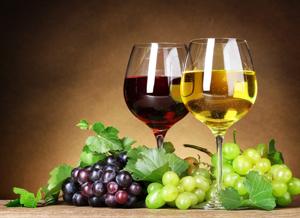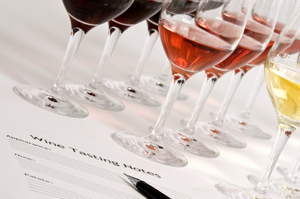It may seem somewhat obvious that the difference between red and white wine is the color. Although that is true to some extent, the differences go much deeper, both in the vineyard and during wine production.
Grape skins contain high concentrations of flavor and tannin compounds, which give wines their signature varietal flavors. Red wines will develop flavors and aromas of red, black and blue fruit – cherry, raspberry, strawberry, blackcurrant, etc. White wines will develop flavors and aromas of green, citrus and stone fruit – apple, lemon, peach, pear, etc.
The skins also contain color compounds – red wines are produced from black-skinned grapes and white wines are produced from white-skinned grapes. The pulp on the inside of most grapes is colorless and made up mostly of water, sugar and acids. Regardless of skin color, when you crush most grapes, the juice will run clear.
Beyond color and flavor, the biggest difference between red and white wines is how they are made. Although winemakers may choose to use different production methods, white wine production is generally about retaining the more delicate flavors and aromas found in white grapes. Red wine making is focused on extracting color, richer flavors and tannins. These objectives are achieved in the winery through critical variations in the production process:
Skin Contact
Typically, after the grapes are harvested and brought into the winery, they are immediately crushed to release the juices. The juice used for white wine spends very little time in contact with the grape skins. It is quickly separated from the grape pulp and stored in sealed, stainless steel tanks. Limiting skin contact ensures the bitter tannins in the skins won’t overwhelm the fruit, and sealed tanks help reduce oxygen contact that can destroy delicate fruit flavors and aromas.
When making red wine, the skins may soak (or “macerate”) in the grape juice for a period of time before alcoholic fermentation is started, allowing the color and flavor compounds in the skins to bleed into the juice.
Fermentation
White wine is often fermented in sealed, stainless steel tanks under cooler temperatures to protect delicate fruit characteristics that can be lost at higher temperatures.
Red wine is fermented at higher temperatures, which is necessary to extract color, flavors and tannins from the skins. The skins and pulp that remain in the juice is called the “cap”. Red wine fermentation often occurs in open-top vats allowing winemakers easy access so they can agitate the cap regularly to further extract color, flavors and tannins into the juice.
Post-Fermentation & Maturation
After alcoholic fermentation is complete, white wines that are intended to have a light, fruity, aromatic style (e.g., Sauvignon Blanc and Riesling) are bottled as soon as possible with no further winemaking processes occurring. Other white wines that are less fruity and meant to be fuller bodied (e.g., Chardonnay) may undergo techniques such as malolactic fermentation (MLF), lees stirring, and oak maturation, depending on the style of wine the winemaker is trying to achieve.
MLF uses bacteria to convert tart malic acid (think green apples) into soft lactic acid (think milk), giving wines like Chardonnay that buttery, creamy texture. Lees are dead yeast cells leftover after alcoholic fermentation. Rather than filtering out the lees immediately, winemakers may keep them in contact with the wine for a period of time to create a richer texture and add yeasty, bread-like flavors. Maturing the wine in oak barrels for a short time will impart some tannins and flavors such as toast, vanilla, cinnamon and smoke into the wine.
For red wines that have completed alcoholic fermentation, the winemaker may choose to further macerate the skins with the wine depending on the ultimate style the winemaker wants to achieve – the longer the post-fermentation maceration, the more tannins will be extracted and the smoother (less bitter and astringent) those tannins will become.
Most red wines undergo MLF, but they don’t typically spend time on their lees because the delicate lees characteristics would be lost in the bolder flavors of red wine. Red wine is then often stored and aged in oak barrels anywhere from 6 months to four years, with typical aging duration between 12-18 months. The longer the amount of time spent in barrels, the greater the concentration of oak characteristics imparted into the wine.
Blending
Fruity, aromatic white wines are usually bottled as single varietals to let the purity of the fruit, with their more delicate flavors and aromas, shine through.
Red wines are more often blended. Blends can be made from different grape varieties, the same varieties grown in different sites, or the same grapes that have undergone different winemaking processes (e.g., aged longer, use of more or less oak, etc.). Blending can add complexity to a finished wine, or balance out certain aspects of a wine, such as color, body, tannin or flavor.
Ageability
The factors that help wines age are acidity, tannins, alcohol and sugar. In general, full-bodied reds like Cabernet Sauvignon, Barolo and Bordeaux can age for a longer period time (some for decades) because they contain high levels of tannin from skin contact and oak aging, along with having higher alcohol levels.
Certain full-bodied whites, such as high quality Chardonnay, can be cellared for 7-10 years due high acidity and tannins imparted by oak aging. However, most white wines are meant to be drunk young, usually within 1-3 years. Light and fruity white wines like Sauvignon Blanc and Pinot Grigio will lose their delicate aromas and flavors very quickly in the bottle. Similarly, lighter red wines, such as Pinot Noir, that don’t have the same high tannins and alcohol as bigger red wines should be drunk young.
Decanting
Older red wines that have been resting in a bottle for many years can throw off sediment that looks ugly in the glass, leaves an unpleasant gritty texture in the mouth if drunk, and can make a wine taste more astringent. Decanting will gently separate out the sediment, leaving it behind in the bottle, so you can enjoy a beautiful glass of aged red wine poured from a decanter.
Decanting can also aerate a wine that might be young and tight. As the wine is poured into a decanter, it comes into contact with oxygen that helps smooth out rough tannins and open up aromas and flavors. Aeration particularly benefits full-bodied, highly tannic red wines like Cabernet Sauvignon, Bordeaux, and Syrah.
Young, fresh white wines are unlikely to require decanting. However, fuller-bodied, more complex white wines can benefit from decanting in the same way as red wines. White wines like Chardonnay may open up, developing more nuanced flavors and aromas with decanting. There is even a new trend in decanting older vintage Champagnes to soften the bubbles and reveal more complex flavors.
The differences between red and white wine are more than skin deep. The skins help determine color and some flavors, but winemaking practices significantly influence the final style of wine that ends up in your glass. What’s your favorite color and style of wine?

